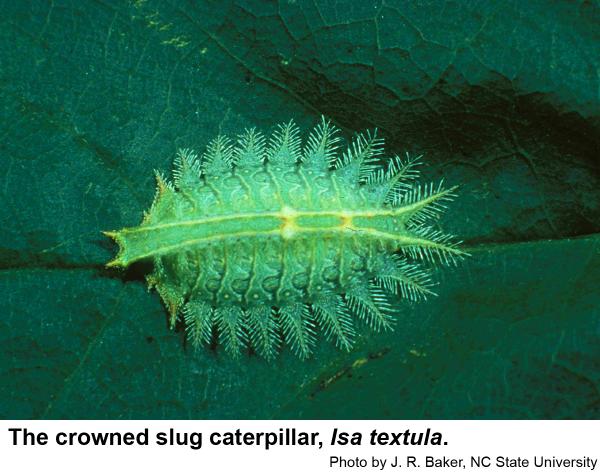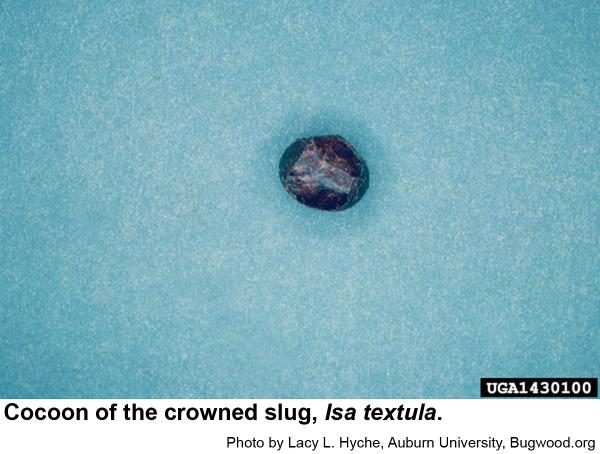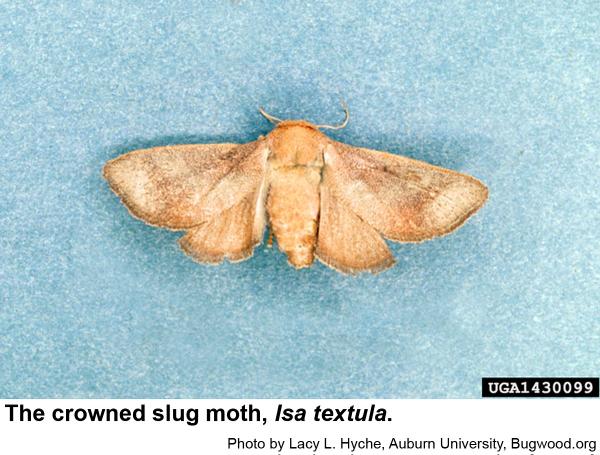Description and Biology
The crowned slug caterpillar, Isa textula, is one of the most exquisite caterpillars in the whole animal kingdom! These caterpillars are flattened, oval, and pastel green with plumes of stinging hairs around the perimeter and shorter, less conspicuous stinging hairs on top. Two pale lines down the back terminate in a pair of "horns" on the front and a pair of stinging plumes on the rear. Some individuals have small, red dots on the back and have some red markings on the front edge. These caterpillars are found feeding during the summer and fall—even as trees are starting to turn their fall colors. When mature, the caterpillars spin inconspicuous, dense, slightly oval cocoons inside of which they pupate. Not much is available on the biology of crowned slug caterpillars. The moths are in flight from May to August. The moths have brownish wings and are about 3/4 inch long with a one inch wing span. The forewings are brown with inconspicuous gray shading. If it is like other slug caterpillars, this one overwinters in a cocoon. The following season, moths emerge to mate and lay eggs for a new generation of caterpillars. We probably have one generation per year.
Host Plants
Crowned slug caterpillars feed on various hardwoods including cherry, elm, hickory, linden, maple, oak, Prunus species, Norway maple, and "other trees and shrubs."
Residential Recommendations
The crowned slug caterpillar is undoubtedly susceptible to various pesticides labeled for landscape use, but it is so rarely encounted that a preventative treatment is not necessary. Be careful if phisically removing stinging caterpillars, as their stings are quite uncomfortable and the symptoms can last for several days.
Other Resources
- Crowned Slug Moth, Isa textula (Herrich-Schäffer, 1854). Kelly Lotts K. and T. Naberhaus. 2019. Butterflies and Moths of North America.
- Species Isa textula - Crowned Slug Moth - Hodges#4681. Elliott, L. et al. 2023 (last update). BugGuide, Iowa State University, Dept. Plant Path., Entomology, and Microbiology.
- Extension Plant Pathology Publications and Factsheets
- Horticultural Science Publications
- North Carolina Agricultural Chemicals Manual
For assistance with a specific problem, contact your local N.C. Cooperative Extension center.
This Factsheet has not been peer reviewed.
Publication date: May 6, 2019
Reviewed/Revised: Feb. 19, 2024
N.C. Cooperative Extension prohibits discrimination and harassment regardless of age, color, disability, family and marital status, gender identity, national origin, political beliefs, race, religion, sex (including pregnancy), sexual orientation and veteran status.



